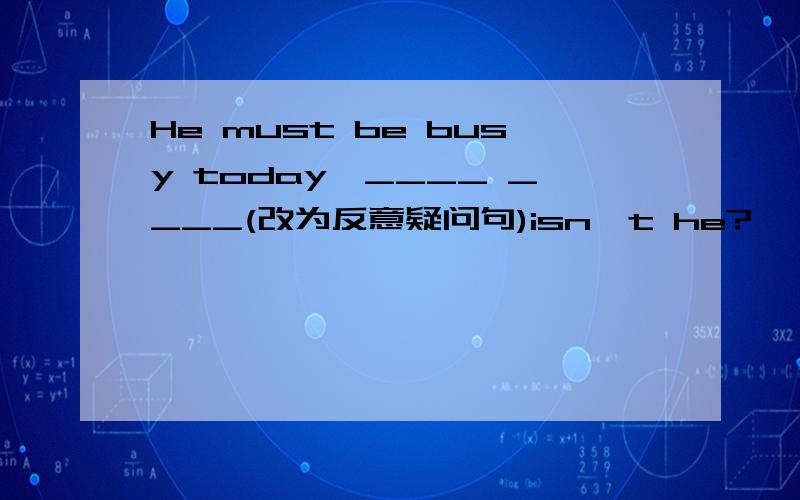He must be busy today,____ ____(改为反意疑问句)isn't he? 为什么呢?并说下什么时候能用 mustn't be?mustn't he?
来源:学生作业帮助网 编辑:作业帮 时间:2024/04/28 17:52:13

He must be busy today,____ ____(改为反意疑问句)isn't he? 为什么呢?并说下什么时候能用 mustn't be?mustn't he?
He must be busy today,____ ____(改为反意疑问句)
isn't he? 为什么呢?并说下什么时候能用 mustn't be?
mustn't he?
He must be busy today,____ ____(改为反意疑问句)isn't he? 为什么呢?并说下什么时候能用 mustn't be?mustn't he?
mustn't是千万不要,意思不对.
这题可以从汉语角度考虑.
must表示推测时意为“一定,肯定”.
He must be busy today,_____?他今天一定很忙,是吗?
“是吗?”问的是什么呢?不是“一定吗?”而是“是很忙吗?”所以不能就must来问,而是就He is busy来问.更何况musn't是“千万不要”,更不用想了.
这很好理解的。
当碰到must这种情况时,将句子翻译
——他今天一定是在忙,不是吗? 所以用 isn't he?
当陈述部分有情态动词must,问句有4种情况:
(1)mustn't表示“禁止,不可,不必”时,附加问句通常要用must.
You mustn't stop your car here,must you?
你不能把车停在这地...
全部展开
这很好理解的。
当碰到must这种情况时,将句子翻译
——他今天一定是在忙,不是吗? 所以用 isn't he?
当陈述部分有情态动词must,问句有4种情况:
(1)mustn't表示“禁止,不可,不必”时,附加问句通常要用must.
You mustn't stop your car here,must you?
你不能把车停在这地方,知道吗?
(2)must表示“有必要”时,附加问句通常要用needn't.
They must finish the work today,needn't they?
他们今天要完成这项工作,是吗?
(3)当must用来表示对现在的情况进行推测时,问句通常要根据must后面的动词采用相应的形式。
He must be good at English,isn't he?
他英语一定学得很好,是吗?
(4)当must+have done表示对过去的情况进行推测(一般句中有明确的过去时间状语),问句要根据陈述部分谓语的情况用“didn't+主语”或“wasn't/weren't+主语”;如果强调动作的完成(一般没有明确的过去时间状语),问句要用“haven't/hasn't+主语”。
She must have read the novel last week,didn't she?
她上星期一定读了这本小说,是吗?
You must have told her about it,haven't you?
你一定把这事告诉她了,是吗?
收起
陈述部分有must 的疑问句,疑问部分根据实际情况而定。
A.must表示“应该”,其疑问部分用mustn't(不应该),如:You must work hard next term, mustn't you ? 下学期你应该努力学习,对吗?
B.must表示“必须”,其疑问部分用needn't(不必),如:They must finish the work toda...
全部展开
陈述部分有must 的疑问句,疑问部分根据实际情况而定。
A.must表示“应该”,其疑问部分用mustn't(不应该),如:You must work hard next term, mustn't you ? 下学期你应该努力学习,对吗?
B.must表示“必须”,其疑问部分用needn't(不必),如:They must finish the work today, needn’t they? 他们今天必须要完成这项工作,是吗?
C.陈述部分含情态动词mustn't,表示禁止时,疑问部分就可以用must或may,如:You mustn’t stop your car here, must you? (may we?)你不能把车停在这地方,知道吗?
D.must表示推测 ,其疑问部分必须与must 后面的主要动词相呼应。
①对现在动作或存在的情况的推测 :
You must know the answer to the exercise, don't you? 你一定知道这项练习的答案,是不是?
②对过去发生的动作或存在的情况的推测:
a 表示肯定推测
(一)句中陈述部分没有表示过去的时间状语,这时疑问部分中的动词就用现在完成时。(haven’t / hasn’t + 主语) 如:You must have told her about it, haven’t you? 你一定把这事告诉她了,是吗?
(二)陈述部分有表示过去的时间状语,疑问部分的动词就用一般过去时。(didn’t + 主语) 如:She must have read the novel last week, didn’t she? 她上星期一定读了这本小说了,是吗?
b 表示否定推测 表示推测时,否定式通常不是must not,而是can't (cannot)
.如: He can't have been to your home; he doesn't know your address, does he? 他不可能去过你家;他不知道你的地址,是不是?
收起
因为有be动词,而且前面是肯定句
没有情况用MUSTN'T be